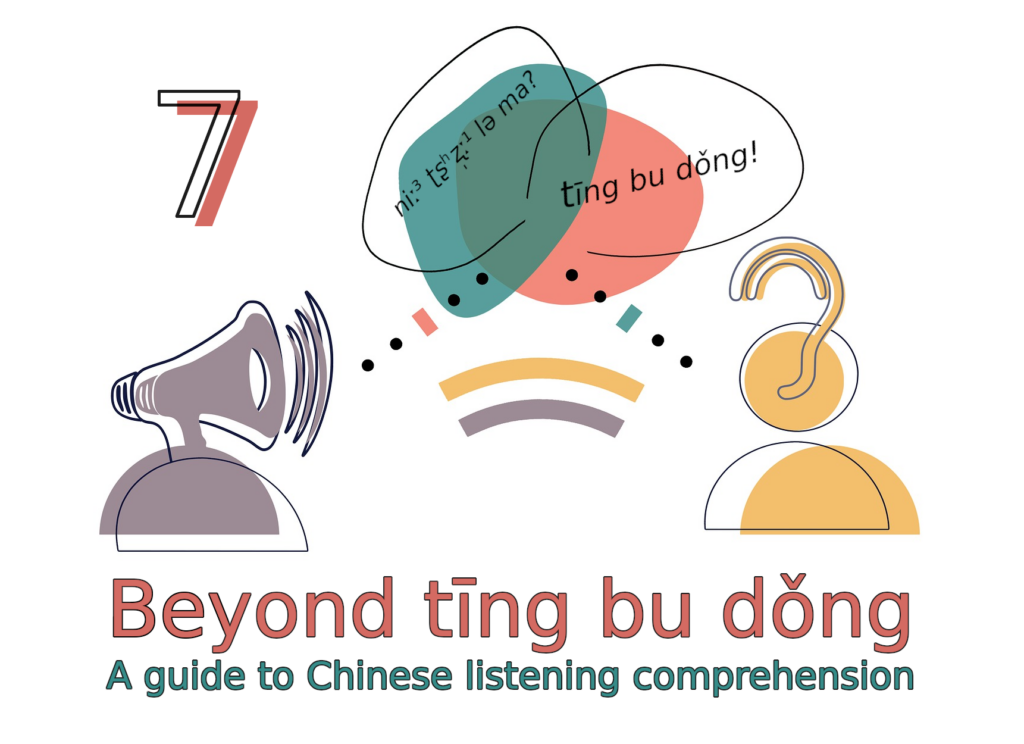 Listening is an essential skill in language learning, but not all listening situations are the same. By recognising different types of listening situations and understanding what each requires, you can improve your chances of successfully navigating spoken Mandarin.
Listening is an essential skill in language learning, but not all listening situations are the same. By recognising different types of listening situations and understanding what each requires, you can improve your chances of successfully navigating spoken Mandarin.
Listening in two directions
To begin with, we can split listening into two types based on which way information flows:
- One-way listening: You listen without influencing what is being said. You might still have some control over how you engage with the material, but you do not take part in the spoken interaction itself.
- Two-way listening: You listen and participate in the conversation. In addition to understanding what is being said, you are also required to contribute information, thoughts or opinions yourself.
At first glance, it would seem like two-way listening is strictly more challenging than one-way listening, and this is often the case, but not always.
For example, when you are in the conversation yourself, it is more likely that the other participants take this into consideration. They might, among other things, slow down their rate of speech, choose words they think you will understand and generally not just assume you know lots of things that you do not.
Tune in to the Hacking Chinese Podcast to listen to the related episode (#252):
Available on Apple Podcasts, Spotify, YouTube and many other platforms!
Beyond tīng bu dǒng: A guide to Chinese listening comprehension

This article is part of a series where we go beyond merely noting that we don’t understand something (tīng bu dǒng) to analyse why we don’t understand and by extension what we can do about it. While it’s recommended that you read or listen to the earlier articles before reading this one, I will refer to earlier articles when relevant. Here’s a list of the articles I’ve planned for this series. Article titles without links have not been published yet!
One-way listening: less active but still demanding
When engaged in one-way listening, such as listening to a podcast, overhearing a conversation on public transport or watching a YouTube video in Chinese, you can focus completely on comprehension.
This feels safer because your understanding is typically not probed outside of test-taking, and it is also more convenient because you can rely on recorded material. This also enables you to use tools that can be tricky to apply in two-way listening, such as adjusting the rate of speech, adding subtitles, or simply hitting the replay button to listen again.
Listen more than once: How the replay button can help you learn more Chinese
On the other hand, not being able to directly participate normally also means that you cannot affect what other people say or how they say it. In fact, in most cases, you are not part of the target audience (authentic content aimed at native speakers, more about this later), or when you are, this is in a general sense, such as when listening to something aimed at learners, albeit not you specifically.
As we have seen throughout this series, it would be wrong to say that one-way listening is “passive”, but it’s less active in the sense that you’re not required to output language yourself. Listening comprehension is always an active process.
Spontaneous vs. scripted content
What one-way listening feels like and how hard it is is closely related to how it was produced. More specifically, it matters how well-planned it is. Let us explore a spectrum between spontaneous speech (no planning at all) and text read aloud (fully planned).
- Spontaneous speech (e.g., casual conversations) contains pauses, fillers, self-corrections and redundancies, making it lower in information density and easier to process. However, the fact that it is not planned can make it harder to follow. Speakers also often omit details when talking to someone familiar, unlike when addressing a general audience.
- Planned speech (e.g., interviews) is less spontaneous when it comes to what is being said. During an interview, both parties probably know roughly what they are going to talk about, making the structure easier to follow. Unless rehearsed, though, which words are used and how is still improvised on the spot.
- Speech with written support (e.g. presentations) is one step closer to being scripted in that the speaker has written some things down, but typically only keywords. This is how most presentations are done in the real world and it is how I record my podcast. If you have access to speaker notes or related visual support in the form of a digital presentation, this can greatly increase comprehension.
- Scripted content (e.g., movies) is meant to sound spontaneous but is not. Movie dialogues, for example, are meant to sound like real dialogues. The same is true for the dialogues in your textbook. It is worth noting that this type of content typically does not resemble spontaneous speech. If you have ever seen the transcript of a normal conversation, you know what I mean, but if you have not, you are probably vastly overestimating how structured you sound when having a conversation.
- Written Chinese read aloud (e.g. news) is by far the hardest type of one-way listening. Since the content is primarily written, not spoken, the information density is sky-high compared to everything else mentioned here. No unnecessary repetition, no pauses, no redundancies. As discussed in part six of this series, if it is formal Chinese, information density is even higher, making news in Chinese much harder than in most other languages.
As a student, being aware of the type of one-way listening you are engaging in can help you understand why you are struggling with some content and not other content.
Of course, you probably cannot change the type of content in a specific case, but you can make sure you choose listening materials that match your proficiency level. The more advanced your Chinese is, however, the more you should diversify and make sure you do not only listen to one type of content. While it is highly recommended to stay away from audiobooks as a beginner, they are an excellent form of listening practice for more advanced students.
Two-way listening: Interactive conversations
Two-way listening is different from one-way listening because you not only need to understand what’s being said, you also need to participate yourself and negotiate meaning.
The speaking side of conversations is beyond the scope of this article, but it goes without saying that you have less processing power left for listening if you also have to think about what you’re supposed to say next.
Negotiation of meaning is when speakers clarify misunderstandings and adjust their language to ensure communication. This includes rephrasing, asking for clarification, using gestures, or modifying speech to suit the listener.
All this is both cognitively and socially demanding. Depending on your personality, it can be outright scary, which makes listening even harder. The most popular concept describing this phenomenon is probably Stephen Krashen’s Affective Filter Hypothesis, which strives to explain how emotions and anxiety can affect language learning.
Generally speaking, the more people participate in the conversation, the harder it is. One of the hardest listening situations of all is being part of a large-ish group of native speakers talking among themselves, so don’t be discouraged if you find this hard. In such a setting, no one will adapt their language to your level and speakers will take many things for granted that you don’t know.
As a beginner or intermediate student, one-on-one conversations are the best, so let’s talk more about those!
Why you should start with one-on-one conversations
Among all types of listening, one-on-one conversations are the most beneficial for language learners. This is true in general, but it’s particularly true for beginners.
There are several advantages to one-on-one conversations:
- There is a shared purpose and mutual understanding: You are both in the same conversation and in the same context. You both know who the other person is and can adapt what and how you say to that. You share the goal of exchanging information or perhaps entertaining each other.
- You can ask for clarification and negotiate meaning: While this is possible in conversation with more than two participants, it’s socially more awkward to do this often if this impacts several people who might not need the clarification you’re asking for. This could be awkward in one-on-one conversations if done too often as well, but less so.
- There is less variation in speakers and topics: In a group of two, you’re an active part in every possible interaction, but that’s not true for groups of three or more. Following other people talking to each other is much harder than following when someone is speaking with you specifically.
- Your conversation partner can adapt to your level appropriately: As all teachers know, doing this in a group of students on different levels is hard, but in a one-on-one conversation, this is not a problem.
You have several options for finding conversation partners. If you’re the extroverted kind and happen to live where there are native speakers of Chinese around, you can just talk to them. Some will not be interested in talking with you, others will.
You can also find a language exchange partner and agree to spend a certain amount of time speaking each other’s language.
Better still, if you have the money, hire a professional tutor and talk with them. They are not guaranteed to be perfect conversational partners, but if you make it clear what you’re after, they’re more likely to be able to help you than anybody else.
Different types of listening bring different challenges
I hope it’s clear by now that “listening” is not a singular activity with fixed parameters. Instead, there are many types of listening with their own characteristics.
Merely being aware of this can help you in several ways.
First, it allows you to adjust the difficulty. Typically, you mostly want to listen to things you can make sense of (see The Input Pyramid: Chinese Listening for Any Situation for more about this).
Are group conversations too hard? Try one-on-one sessions instead!
Do you find written Chinese read aloud too hard? Try more spontaneous speech instead!
Second, knowing about different types of listening can help you analyse your current listening ability. This whole series is about not being content with simply saying tīng bu dǒng and giving up. Instead, we want to understand why we don’t understand, and knowing how different types of listening work is crucial for that.
If you want more guidance when it comes to how to listen and what to listen to, including a structured resource library suitable for any level, along with strategies for Chinese immersion on your terms, check out my course The Fluent Listener: Navigating Spoken Mandarin Like a Fish in Water.

